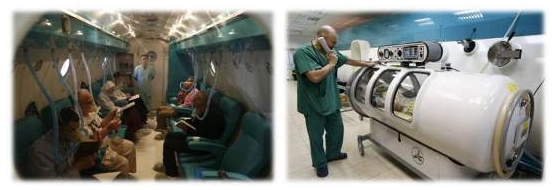UHMS Definition of Hyperbaric Oxygen Treatment
“The patient breathes 95%, 100% oxygen or ‘Heli-Ox’ depending on the set protocol, intermittently while the pressure of the treatment chamber is increased to greater than one atmosphere absolute (atm abs). Current information indicates that pressurization should be at least 1.4 atm abs. This may occur in a single person chamber (monoplace) or multiplace chamber (may hold 2 or more people). Breathing 100% oxygen at 1 atm abs or exposing isolated parts of the body to 100% oxygen does not constitute HBO2 therapy.”

Hyperbaric Oxygen treatment sets into motion cumulative processes promoting immediate and delayed healing activities. The curing effects activated by hyperbaric oxygen do not stop when patient leaves the chamber.
Hyperbaric Oxygen Treatment flow…
- Patient inhales 95%, 100% oxygen or ‘Heli-Ox’ depending on the set protocol, while atmospheric pressure inside hyperbaric chamber is above 1.4 ATA
- Oxygen concentration in body fluids rises up to 2000% above the normal level – equivalent of 1,500-2000 mmHg of arterial oxygen values
- Oxygen-reach plasma transports oxygen to tissues and bones up to 3-4 times deeper then normally
- Body tissues and bones supplied with up to 20 times higher its normal oxygen supply
- From the beginning of HBO treatment immediate as well as delayed secondary effects of healing are promoted
Immediate healing effects of hyperbaric oxygen treatment are activated when hyperoxygenation of tissues is achieved. The immediate effects of hyperoxygenation are…
- Increased oxygen saturation of body fluids, mainly plasma, boosts body’s capacity to transport oxygen
- Greater oxygen diffusion distance in tissues and bones promotes over-delivery of vital energy source for cells to maintain their metabolic life. Learn about Aerobic Cellular Respiration…
Delayed secondary effects of Hyperbaric Oxygen Therapy are having prolonged, continued activity of great value…
- fibroblast proliferation which playing a key role in restoring connective tissues
- restored oxygen traffic between ischemic sites and surrounding healthy tissues
- inhibition of toxins in infected tissues present in conditions like gas gangrene or necrosis
- decreasing sites of edema (e.g. fluids accumulated in body tissues or cavities as a result of acute injuries or chronic wounds)
- anti-oxidative actions promoted by oxygen free radicals
- killing anaerobic infections
- formation of new microvascular networks in ischemic tissues, so important in curing chronic wounds, radiation-induced necrosis and other conditions…
